KIA Rio 2014 3.G User Guide
Manufacturer: KIA, Model Year: 2014, Model line: Rio, Model: KIA Rio 2014 3.GPages: 397, PDF Size: 7.56 MB
Page 11 of 397
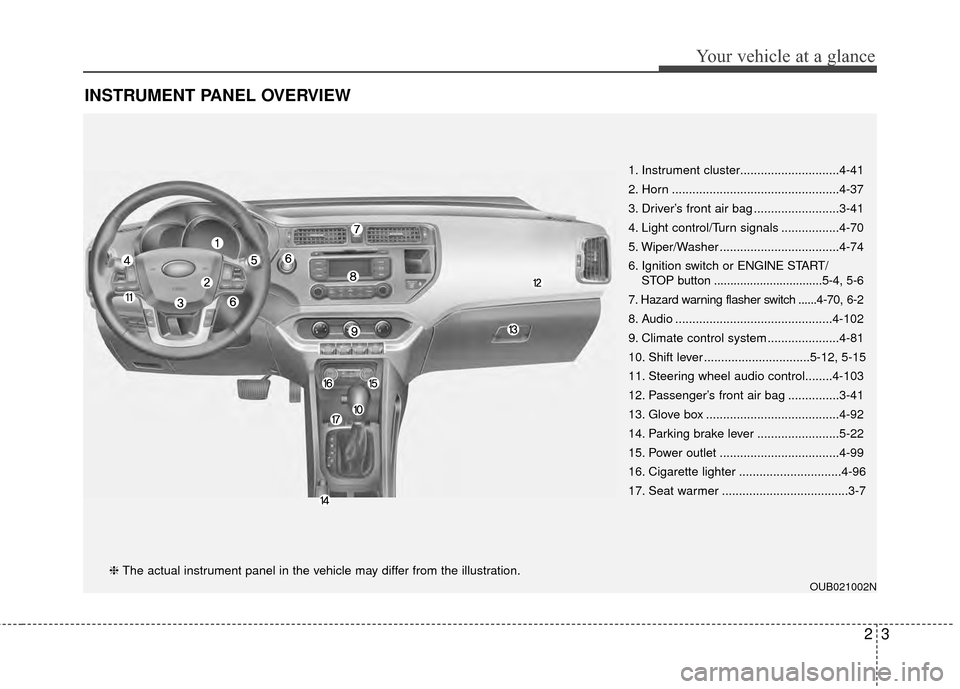
23
Your vehicle at a glance
INSTRUMENT PANEL OVERVIEW
OUB021002N
1. Instrument cluster.............................4-41
2. Horn .................................................4-37
3. Driver’s front air bag .........................3-41
4. Light control/Turn signals .................4-70
5. Wiper/Washer ...................................4-74
6. Ignition switch or ENGINE START/STOP button .................................5-4, 5-6
7. Hazard warning flasher switch ......4-70, 6-2
8. Audio ..............................................4-102
9. Climate control system .....................4-81
10. Shift lever ...............................5-12, 5-15
11. Steering wheel audio control........4-103
12. Passenger’s front air bag ...............3-41
13. Glove box .......................................4-92
14. Parking brake lever ........................5-22
15. Power outlet ...................................4-99
16. Cigarette lighter ..............................4-96
17. Seat warmer .....................................3-7
❈ The actual instrument panel in the vehicle may differ from the illustration.
Page 12 of 397
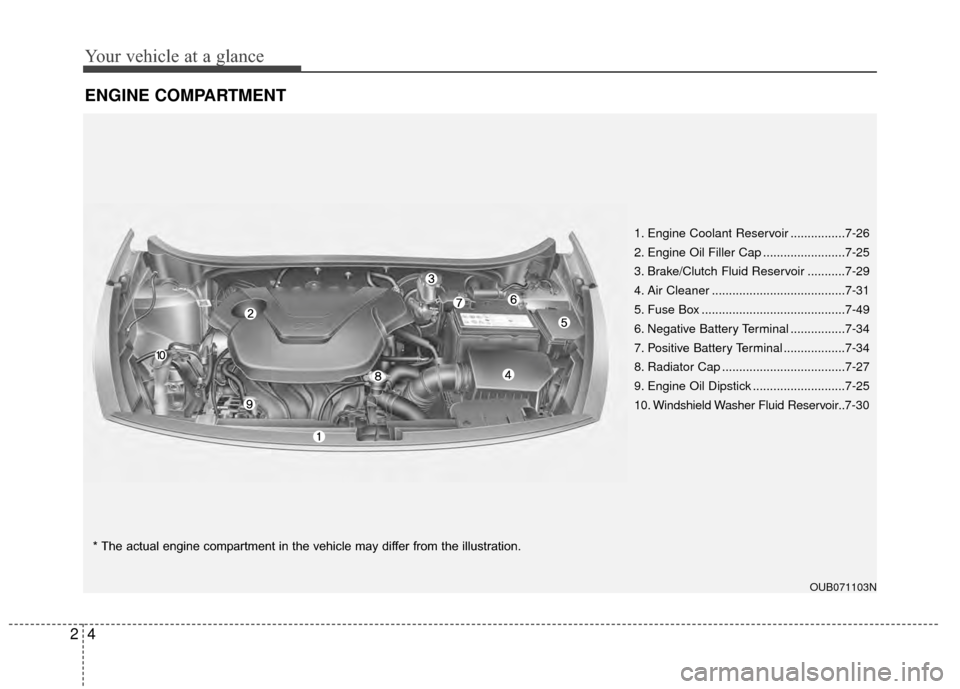
Your vehicle at a glance
42
ENGINE COMPARTMENT
OUB071103N
* The actual engine compartment in the vehicle may differ from the illustration.1. Engine Coolant Reservoir ................7-26
2. Engine Oil Filler Cap ........................7-25
3. Brake/Clutch Fluid Reservoir ...........7-29
4. Air Cleaner .......................................7-31
5. Fuse Box ..........................................7-49
6. Negative Battery Terminal ................7-34
7. Positive Battery Terminal ..................7-34
8. Radiator Cap ....................................7-27
9. Engine Oil Dipstick ...........................7-25
10. Windshield Washer Fluid Reservoir..7-30
Page 13 of 397
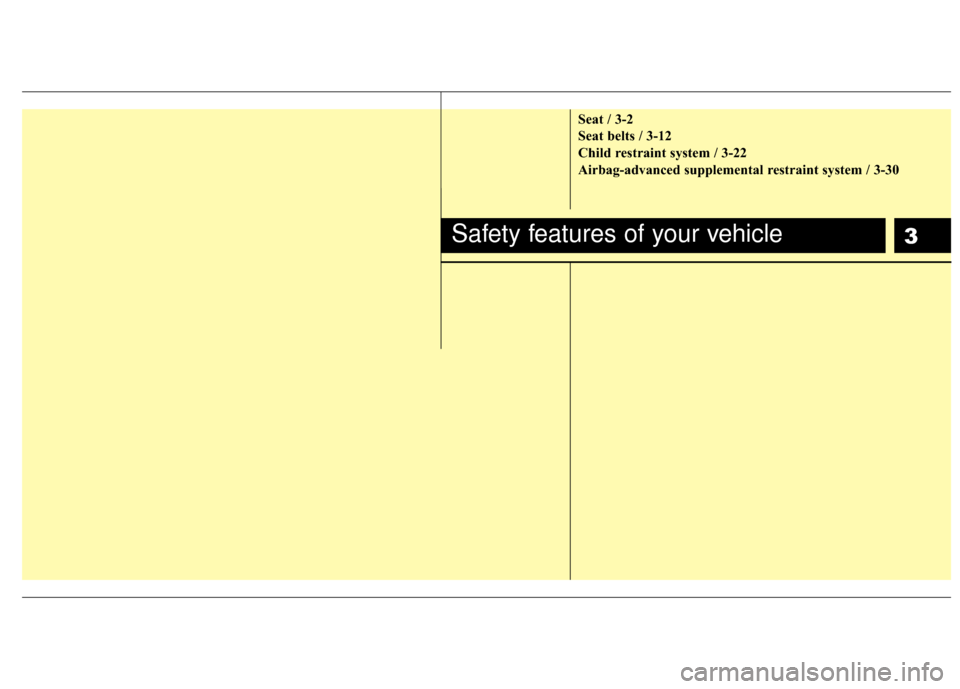
3
Seat / 3-2
Seat belts / 3-12
Child restraint system / 3-22
Airbag-advanced supplemental restraint system / 3-30
Safety features of your vehicle
Page 14 of 397
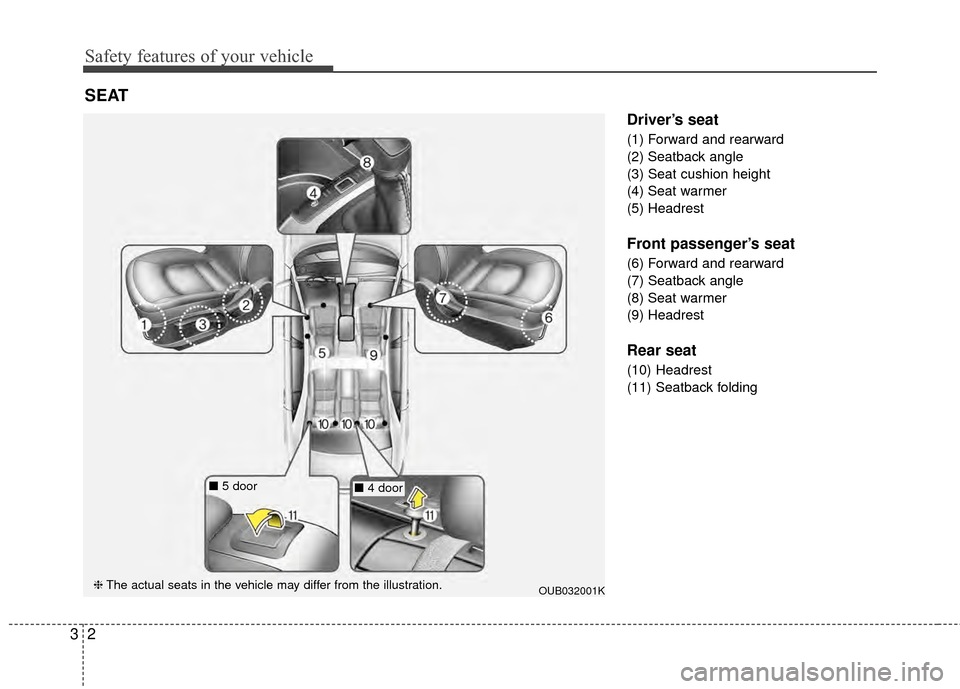
Safety features of your vehicle
23
Driver’s seat
(1) Forward and rearward
(2) Seatback angle
(3) Seat cushion height
(4) Seat warmer
(5) Headrest
Front passenger’s seat
(6) Forward and rearward
(7) Seatback angle
(8) Seat warmer
(9) Headrest
Rear seat
(10) Headrest
(11) Seatback folding
SEAT
OUB032001K
■5 door■4 door
❈ The actual seats in the vehicle may differ from the illustration.
Page 15 of 397
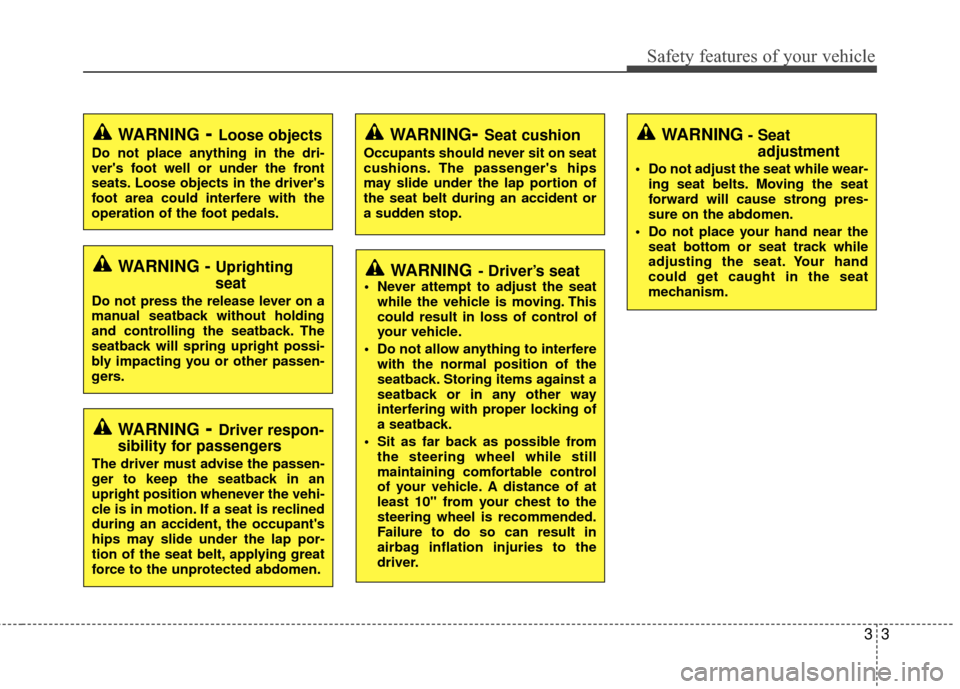
33
Safety features of your vehicle
WARNING- Driver’s seat Never attempt to adjust the seatwhile the vehicle is moving. This
could result in loss of control of
your vehicle.
Do not allow anything to interfere with the normal position of the
seatback. Storing items against a
seatback or in any other way
interfering with proper locking of
a seatback.
Sit as far back as possible from the steering wheel while still
maintaining comfortable control
of your vehicle. A distance of at
least 10" from your chest to the
steering wheel is recommended.
Failure to do so can result in
airbag inflation injuries to the
driver.
WARNING - Uprighting
seat
Do not press the release lever on a
manual seatback without holding
and controlling the seatback. The
seatback will spring upright possi-
bly impacting you or other passen-
gers.
WARNING- Loose objects
Do not place anything in the dri-
ver's foot well or under the front
seats. Loose objects in the driver's
foot area could interfere with the
operation of the foot pedals.
WARNING- Driver respon-
sibility for passengers
The driver must advise the passen-
ger to keep the seatback in an
upright position whenever the vehi-
cle is in motion. If a seat is reclined
during an accident, the occupant's
hips may slide under the lap por-
tion of the seat belt, applying great
force to the unprotected abdomen.
WARNING- Seat cushion
Occupants should never sit on seat
cushions. The passenger's hips
may slide under the lap portion of
the seat belt during an accident or
a sudden stop.
WARNING- Seat adjustment
Do not adjust the seat while wear-
ing seat belts. Moving the seat
forward will cause strong pres-
sure on the abdomen.
Do not place your hand near the seat bottom or seat track while
adjusting the seat. Your hand
could get caught in the seat
mechanism.
Page 16 of 397
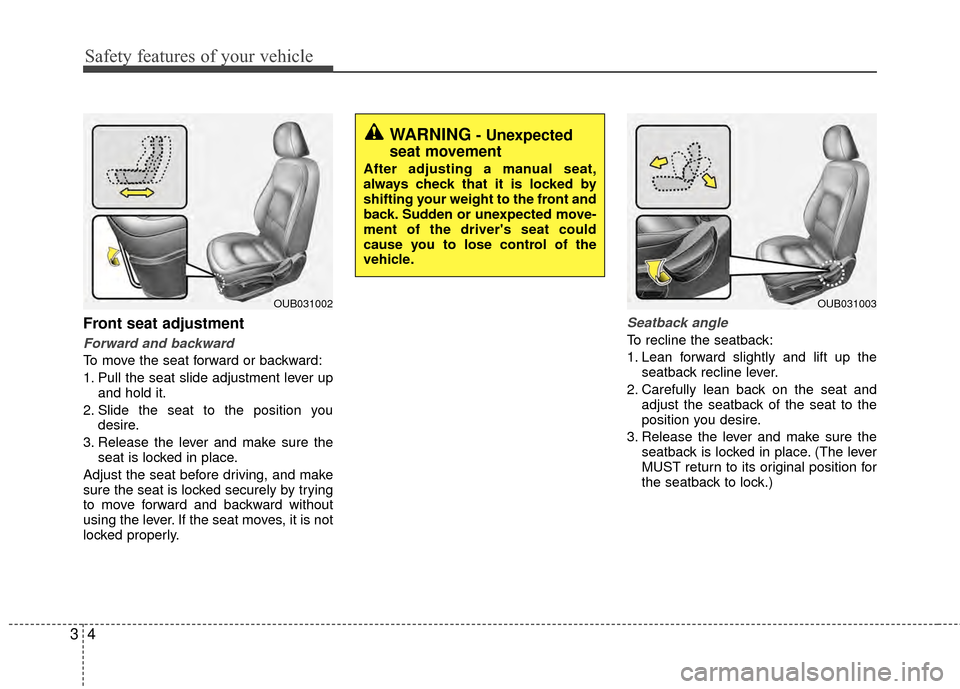
Safety features of your vehicle
43
Front seat adjustment
Forward and backward
To move the seat forward or backward:
1. Pull the seat slide adjustment lever upand hold it.
2. Slide the seat to the position you desire.
3. Release the lever and make sure the seat is locked in place.
Adjust the seat before driving, and make
sure the seat is locked securely by trying
to move forward and backward without
using the lever. If the seat moves, it is not
locked properly.
Seatback angle
To recline the seatback:
1. Lean forward slightly and lift up the seatback recline lever.
2. Carefully lean back on the seat and adjust the seatback of the seat to the
position you desire.
3. Release the lever and make sure the seatback is locked in place. (The lever
MUST return to its original position for
the seatback to lock.)
OUB031002
WARNING- Unexpected
seat movement
After adjusting a manual seat,
always check that it is locked by
shifting your weight to the front and
back. Sudden or unexpected move-
ment of the driver's seat could
cause you to lose control of the
vehicle.
OUB031003
Page 17 of 397
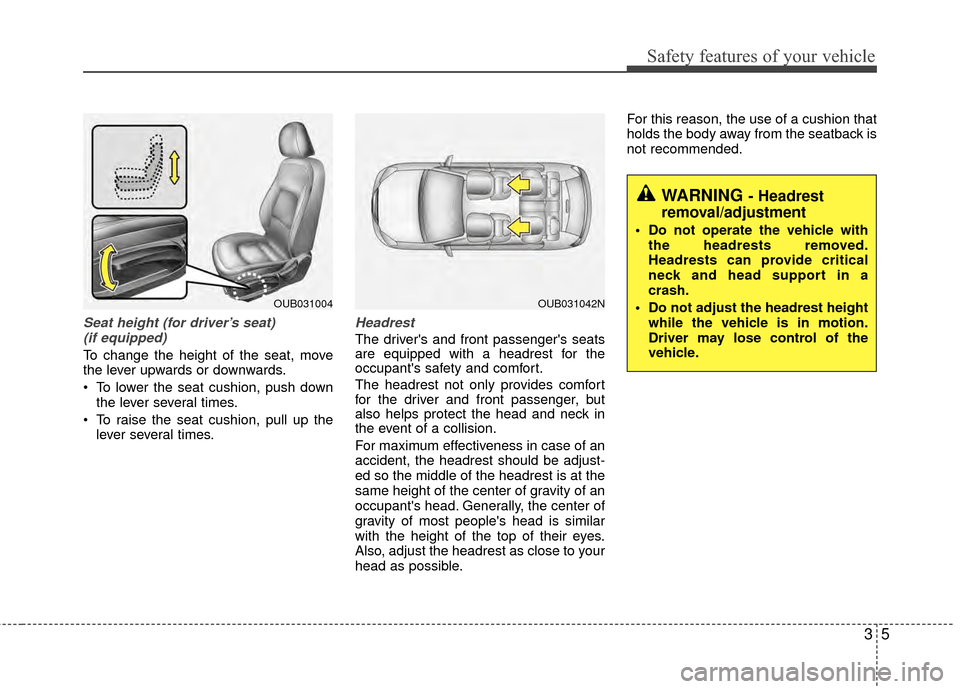
35
Safety features of your vehicle
Seat height (for driver’s seat) (if equipped)
To change the height of the seat, move
the lever upwards or downwards.
• To lower the seat cushion, push down the lever several times.
To raise the seat cushion, pull up the lever several times.
Headrest
The driver's and front passenger's seats
are equipped with a headrest for the
occupant's safety and comfort.
The headrest not only provides comfort
for the driver and front passenger, but
also helps protect the head and neck in
the event of a collision.
For maximum effectiveness in case of an
accident, the headrest should be adjust-
ed so the middle of the headrest is at the
same height of the center of gravity of an
occupant's head. Generally, the center of
gravity of most people's head is similar
with the height of the top of their eyes.
Also, adjust the headrest as close to your
head as possible. For this reason, the use of a cushion that
holds the body away from the seatback is
not recommended.
OUB031004OUB031042N
WARNING - Headrest
removal/adjustment
Do not operate the vehicle with
the headrests removed.
Headrests can provide critical
neck and head support in a
crash.
Do not adjust the headrest height while the vehicle is in motion.
Driver may lose control of the
vehicle.
Page 18 of 397
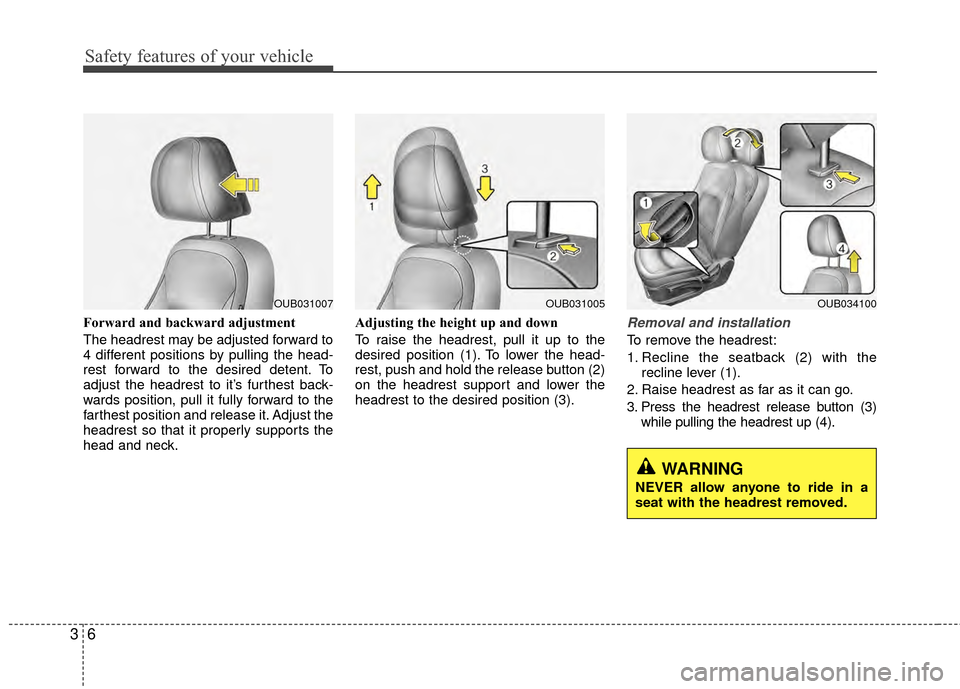
Safety features of your vehicle
63
Forward and backward adjustment
The headrest may be adjusted forward to
4 different positions by pulling the head-
rest forward to the desired detent. To
adjust the headrest to it’s furthest back-
wards position, pull it fully forward to the
farthest position and release it. Adjust the
headrest so that it properly supports the
head and neck.Adjusting the height up and down
To raise the headrest, pull it up to the
desired position (1). To lower the head-
rest, push and hold the release button (2)
on the headrest support and lower the
headrest to the desired position (3).Removal and installation
To remove the headrest:
1. Recline the seatback (2) with the
recline lever (1).
2. Raise headrest as far as it can go.
3. Press the headrest release button (3) while pulling the headrest up (4).
OUB031005OUB031007
WARNING
NEVER allow anyone to ride in a
seat with the headrest removed.
OUB034100
Page 19 of 397
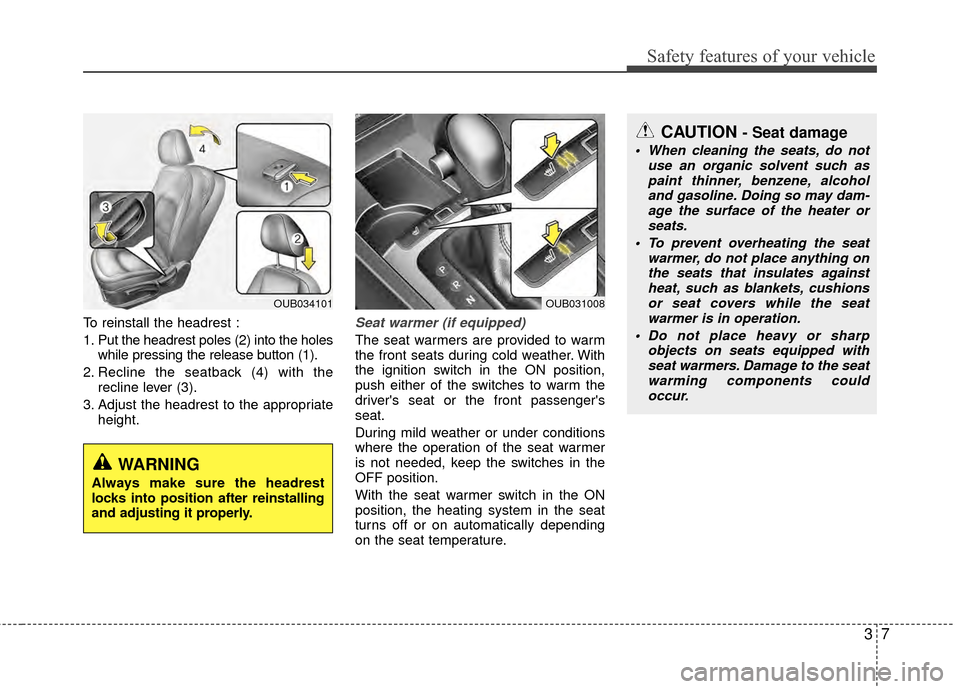
37
Safety features of your vehicle
To reinstall the headrest :
1. Put the headrest poles (2) into the holeswhile pressing the release button (1).
2. Recline the seatback (4) with the recline lever (3).
3. Adjust the headrest to the appropriate height.Seat warmer (if equipped)
The seat warmers are provided to warm
the front seats during cold weather. With
the ignition switch in the ON position,
push either of the switches to warm the
driver's seat or the front passenger's
seat.
During mild weather or under conditions
where the operation of the seat warmer
is not needed, keep the switches in the
OFF position.
With the seat warmer switch in the ON
position, the heating system in the seat
turns off or on automatically depending
on the seat temperature.
OUB031008
CAUTION - Seat damage
When cleaning the seats, do not use an organic solvent such aspaint thinner, benzene, alcohol and gasoline. Doing so may dam-age the surface of the heater orseats.
To prevent overheating the seat warmer, do not place anything onthe seats that insulates against heat, such as blankets, cushionsor seat covers while the seat warmer is in operation.
Do not place heavy or sharp objects on seats equipped withseat warmers. Damage to the seatwarming components couldoccur.
WARNING
Always make sure the headrest
locks into position after reinstalling
and adjusting it properly.
OUB034101
Page 20 of 397
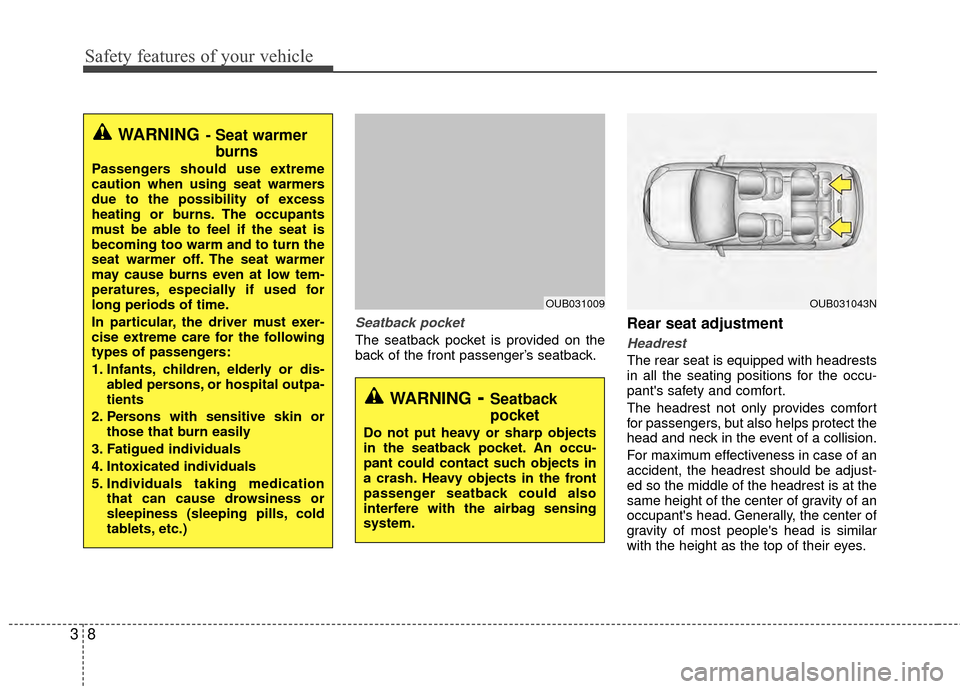
Safety features of your vehicle
83
Seatback pocket
The seatback pocket is provided on the
back of the front passenger’s seatback.
Rear seat adjustment
Headrest
The rear seat is equipped with headrests
in all the seating positions for the occu-
pant's safety and comfort.
The headrest not only provides comfort
for passengers, but also helps protect the
head and neck in the event of a collision.
For maximum effectiveness in case of an
accident, the headrest should be adjust-
ed so the middle of the headrest is at the
same height of the center of gravity of an
occupant's head. Generally, the center of
gravity of most people's head is similar
with the height as the top of their eyes.
WARNING- Seat warmerburns
Passengers should use extreme
caution when using seat warmers
due to the possibility of excess
heating or burns. The occupants
must be able to feel if the seat is
becoming too warm and to turn the
seat warmer off. The seat warmer
may cause burns even at low tem-
peratures, especially if used for
long periods of time.
In particular, the driver must exer-
cise extreme care for the following
types of passengers:
1. Infants, children, elderly or dis-
abled persons, or hospital outpa-
tients
2. Persons with sensitive skin or those that burn easily
3. Fatigued individuals
4. Intoxicated individuals
5. Individuals taking medication that can cause drowsiness or
sleepiness (sleeping pills, cold
tablets, etc.)
WARNING- Seatback
pocket
Do not put heavy or sharp objects
in the seatback pocket. An occu-
pant could contact such objects in
a crash. Heavy objects in the front
passenger seatback could also
interfere with the airbag sensing
system.
OUB031009OUB031043N